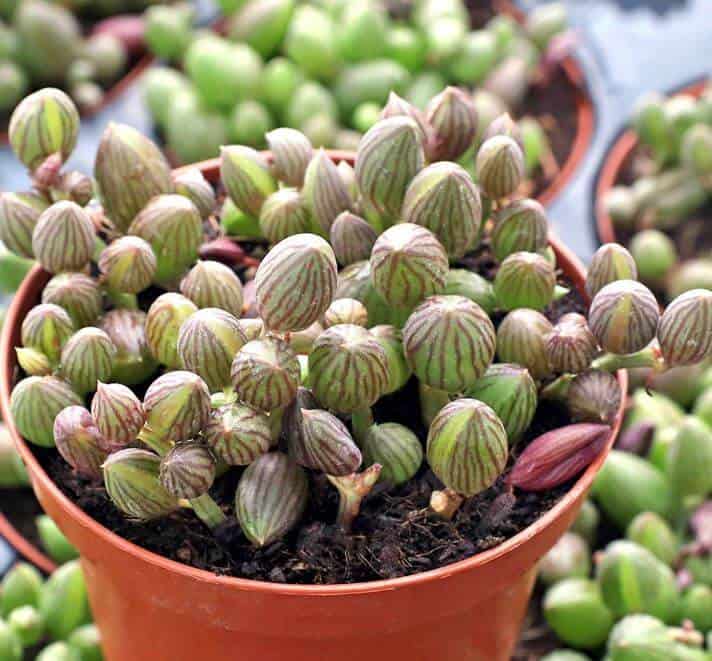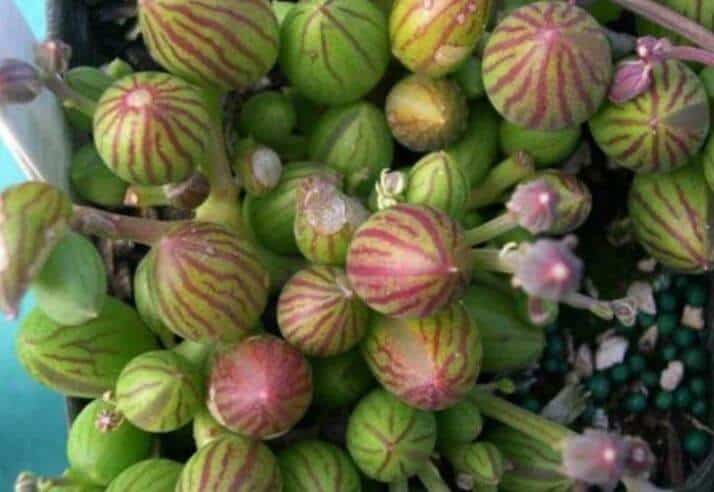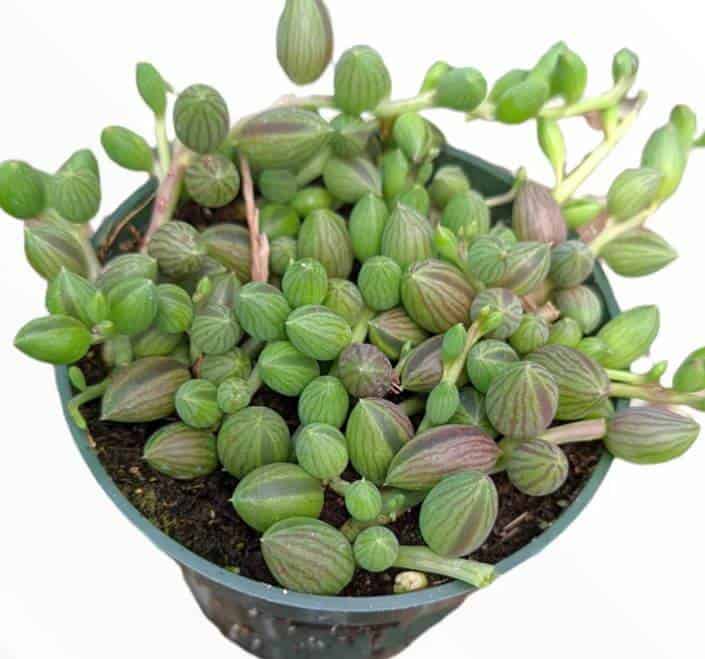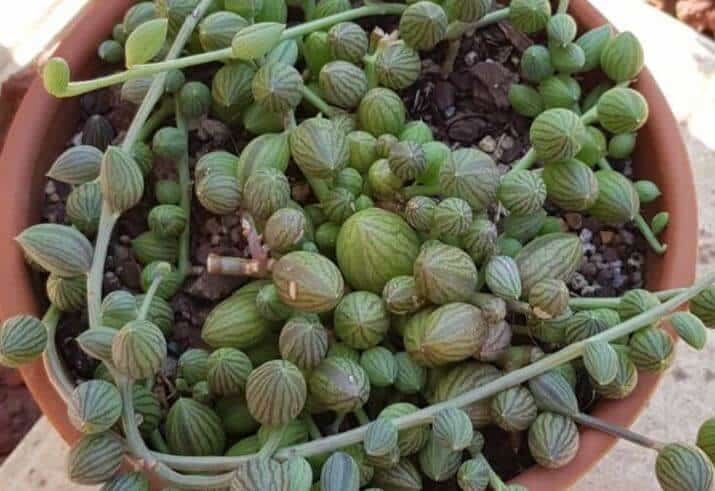Last Updated on January 6, 2023 by a Friendly Gardener
If you are looking for a low-maintenance succulent plant, the string of watermelons plant will be a beautiful addition to your collection.
Scientifically known as Curio herreanus, the beautiful decorative plant is native to South Africa. It sports stripped oval leaves with long trailing stems that can reach up to 12 inches in length.
As a succulent, the plant is quite resistant. It also requires minimal energy to grow and maintain.
This article will guide you through everything you need to know about the string of watermelon plant care.
Optimal Growing Conditions for String of Watermelons Plant

The string of watermelons is a low-maintenance succulent. However, it does not tolerate neglect as well as some other succulents. Therefore, it is important to make sure the basic needs of the plant are being properly met for optimum growth.
Sunlight
When growing the string of watermelons plant outdoors, they thrive in partial shade. In their natural habitat, the succulent creeps on the ground and grows under the shade of other trees.
However, if you are growing the plant indoors, it thrives in bright sunlight. If it does not receive enough light, it will lead to stunted growth. The plant will also slowly begin to lose its characteristic look.
Keep the potted plant facing the west window for best results. Additionally, you can use LED lights as a substitute.
Water

Since the plant is a succulent, you have to be careful with how often and how much water you provide. It is better to underwater the plant than overwater it.
Succulent plants are sensitive to being overwatered. The string of watermelon plant is no exception. Before watering the plant, make sure the top layer of the soil has dried out. But do not keep the drought period between each watering session long.
The general succulent watering schedule is once every week. However, this duration can vary depending on the soil and temperature. During summertime, the plant will need more water than in winter months.
You can also try the soak-and-dry method. In this method, you dunk the pot in water and let the water soak through all layers of the soil. Allow excess water to exit through the drainage holes. Then wait until the soil dries out before watering again.
Overwatering can result in mushy leaves and stems and ultimately spread root rot. Root rot can be fatal for your plant.
Temperature
Since the plant originates from South Africa, it prefers a temperate climate. It thrives in the normal temperature range between 68°F to 95°F.
Though it can withstand short exposure to low temperatures, it prefers warmth. It will not survive long in freezing weather. The plant goes into a semi-dormant state during winter and has minimal water and nutritional needs.
The string of watermelons plant is suited for hardiness zones of 9b to 11b. If you are growing the plant outdoors, you may have to move it indoors when the weather turns extremely cold.
Soil
The type of soil you use for the plant is closely linked to how much and how often you water your string of watermelons.
Since overwatering is fatal to your plant, you will have to use a well-draining soil mix. Additionally, the pot you plan to use will need to have adequate drainage.
You can use a cactus soil mix or mix your own potting mix with perlite for aeration and drainage.
Choose soil that will not retain too much moisture. You can also arrange pebbles or rocks at the base of the pot for drainage.
Fertilizer
You will need to frequently feed the plant some liquid plant food during the growing season. A fertilizer that is rich in phosphorous and potassium is best suited for succulents.
Tone down the use of fertilizer during colder months as the plant’s development and nutritional needs become semi-dormant.
Potting

When it comes to growing succulents, it is a must to use a pot with proper drainage. Pot size does not matter as long as the pot has drainage holes.
Avoid glass and terracotta pots. Glass is not a breathable material, whereas terracotta pots tend to heat up under direct light. Your best option is a plastic pot with adequate drainage holes.
Repotting

The string of watermelons plant does not require repotting. However, you can transfer the plant to a bigger pot if the length of the hanging succulent stems increases.
Though the root system of the plant is rather short, if you notice some roots peeking out of the base of the pot, you can repot the plant into a bigger pot.
You may also need to repot the plant to salvage it from the ruins of overwatering.
Propagating String of Watermelons

There are various ways of propagating the string of watermelon plant. You can use seeds, stem cuttings, offsets, or leaves to grow a new plant.
If you want to propagate using stem cuttings, you will need to snip some healthy stems that are not in bloom. The best time to propagate is during the spring and summer months.
Place the stems in a glass of water. You can use distilled or tap water. Make sure you remove any leaves present at the base of the cutting. Change the water once it becomes hazy. After a fortnight, you should see roots sprouting from the cuttings.
Once the newly developed roots grow an inch in length, place them in a fresh potting mix. Allow the roots two days to adjust to their new environment and lose any excess water before you water the soil.
Conclusion
The variegated string of watermelons is a succulent that is best suited for intermediate growers as well as novice plant owners. It requires easy care but does not take neglect as well as other succulents.
It thrives under care, requiring bright indirect light, a warm temperature, a proper watering pattern, and well-draining soil. As long as you meet its basic needs, you will grow a beautiful and healthy string of watermelons plant.

